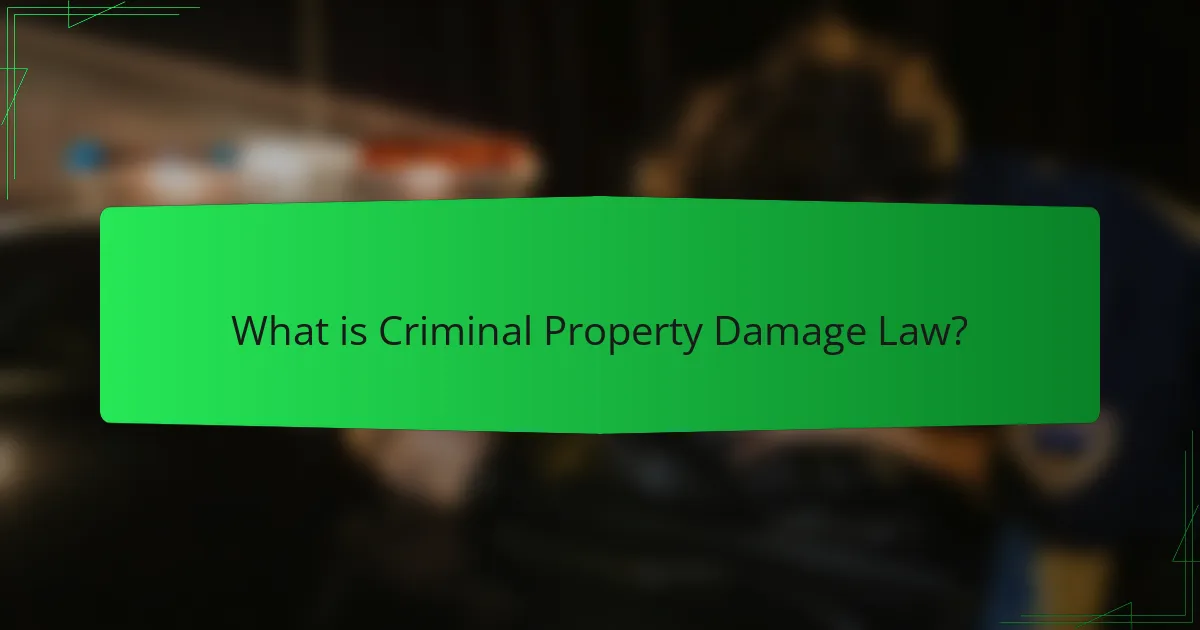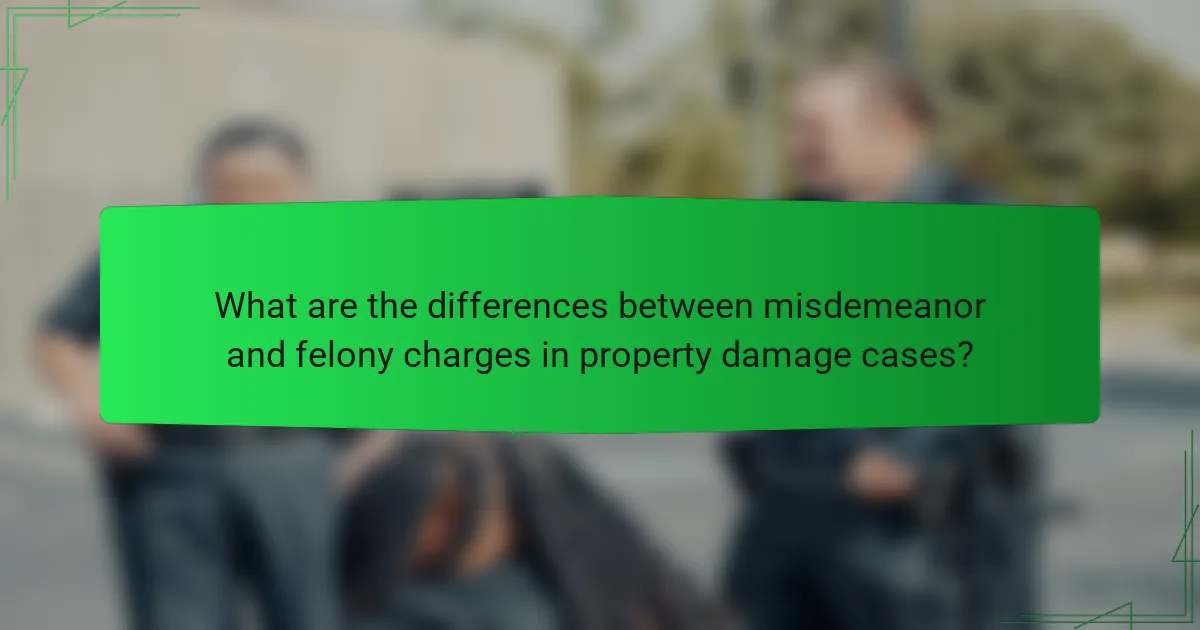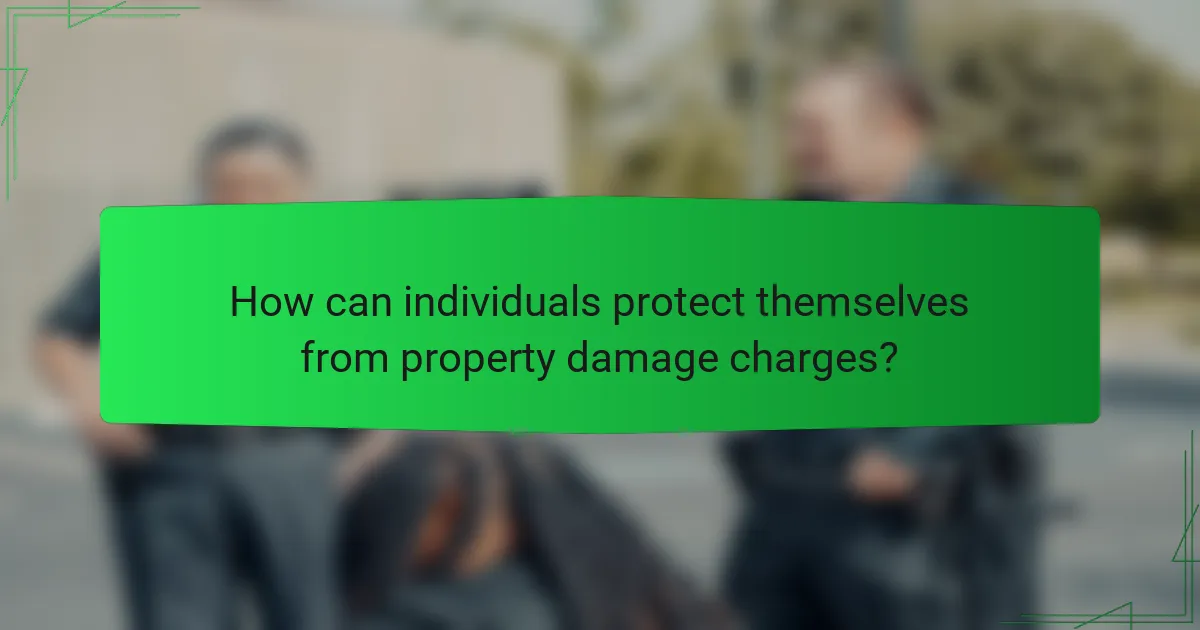Criminal Property Damage Law encompasses the legal guidelines governing the intentional destruction or defacement of another individual’s property. The law differentiates between misdemeanor and felony charges based on the severity of damage and the intent behind the act. Misdemeanor charges typically involve minor damage with lighter penalties, while felony charges pertain to significant destruction, often resulting in harsher consequences. The classification of charges is influenced by the monetary value of the damage and the intent, with specific thresholds determining the severity of the offense. Preventive measures, such as obtaining insurance and understanding local laws, can help individuals avoid potential property damage charges.

What is Criminal Property Damage Law?
Criminal Property Damage Law refers to the legal framework governing the willful destruction or defacement of another person’s property. This law categorizes offenses based on the extent of damage and the intent behind the action. In many jurisdictions, property damage can be classified as either a misdemeanor or a felony. Misdemeanor charges typically involve minor damage, while felony charges involve significant destruction or loss. The law aims to protect property rights and ensure accountability for those who intentionally harm or destroy property. Statutes vary by state, but the core principles remain consistent across jurisdictions.
How are property damage laws defined in legal terms?
Property damage laws are defined as statutes that govern the unlawful destruction or alteration of another person’s property. These laws classify actions that cause physical harm to property, such as vandalism or destruction of real estate. Legal definitions vary by jurisdiction but generally include intentional, reckless, or negligent actions leading to damage. Property damage can be categorized into misdemeanors or felonies based on the severity and value of the damage caused. For example, damages exceeding a specific monetary threshold often elevate the charge to a felony. Understanding these classifications helps determine the appropriate legal consequences for offenders.
What are the key elements that constitute property damage?
Property damage is defined as harm or destruction to physical property. Key elements include the physical alteration of property, loss of value, and the owner’s lack of consent. Physical alteration refers to any change in the property’s condition. Loss of value indicates that the property is worth less after the damage occurs. The owner’s lack of consent emphasizes that damage must occur without the owner’s permission. These elements are crucial in determining liability under criminal property damage law.
How do definitions vary by jurisdiction?
Definitions of criminal property damage vary by jurisdiction due to differing state laws. Each state has its own legal framework that defines what constitutes property damage. For instance, some jurisdictions may classify damage above a certain monetary threshold as a felony. Other jurisdictions may have different thresholds or criteria for misdemeanor charges. Additionally, the intent behind the damage can influence definitions. Certain states may consider reckless behavior as a more severe offense. Variations also exist in penalties and enforcement practices. This inconsistency can lead to different legal outcomes for similar actions in different states. Understanding these definitions is crucial for navigating legal consequences effectively.
What types of property damage are recognized under the law?
The law recognizes several types of property damage. These include physical damage, destruction, and defacement of property. Physical damage refers to any harm that reduces the value or usability of property. Destruction involves completely ruining or rendering property unusable. Defacement includes altering property in a way that diminishes its appearance or value. Additionally, the law may categorize damage based on intent, such as negligent or intentional damage. Each type of damage can lead to varying legal consequences under criminal property damage laws.
What distinguishes between vandalism and accidental damage?
Vandalism is the intentional destruction or defacement of property. Accidental damage occurs without intent to harm. The key distinction lies in the intent behind the action. Vandalism is often motivated by malice or a desire to cause harm. In contrast, accidental damage results from unforeseen circumstances or negligence. Legal definitions support this distinction, as vandalism is typically classified as a criminal offense. Accidental damage may be addressed through civil liability rather than criminal charges. Understanding this difference is crucial in criminal property damage law.
How do different forms of property damage impact legal outcomes?
Different forms of property damage significantly influence legal outcomes. The severity of the damage often determines whether charges are classified as misdemeanors or felonies. For instance, minor damage, such as graffiti, may result in misdemeanor charges. In contrast, extensive damage, like arson, typically leads to felony charges. Legal consequences vary based on the estimated cost of repairs. Damages exceeding a specific monetary threshold often escalate charges to felonies. Additionally, the intent behind the damage plays a crucial role in legal classification. Willful destruction is treated more severely than accidental damage. Courts may also consider prior offenses, which can exacerbate legal repercussions. Thus, the type and extent of property damage directly impact judicial outcomes.

What are the differences between misdemeanor and felony charges in property damage cases?
Misdemeanor charges involve less severe property damage offenses, while felony charges are for more serious offenses. Misdemeanors typically result in lighter penalties, such as fines or short jail time. Felonies carry harsher consequences, including longer prison sentences and larger fines. The value of the property damage often determines the classification of the charge. In many jurisdictions, property damage exceeding a specific monetary threshold is categorized as a felony. For example, damage above $1,000 may lead to felony charges. Misdemeanor property damage usually involves amounts below this threshold. Additionally, the intent behind the damage can influence the charge severity. Reckless or intentional damage is more likely to result in felony charges. In contrast, accidental damage may lead to misdemeanor charges. Understanding these distinctions is crucial for navigating legal consequences in property damage cases.
How is a misdemeanor charge defined in property damage law?
A misdemeanor charge in property damage law is defined as a criminal offense that typically involves minor damage to another person’s property. This type of charge is less severe than a felony and usually results in lighter penalties. The property damage must usually not exceed a specific monetary value, often set by state law, to qualify as a misdemeanor. For example, many jurisdictions define misdemeanor property damage as damage that costs less than $1,000 to repair. Penalties for a misdemeanor charge may include fines, restitution, or a short jail sentence, typically less than one year. This aligns with the general legal framework that categorizes offenses based on severity and potential harm.
What are the typical penalties associated with misdemeanor property damage?
Typical penalties for misdemeanor property damage include fines, restitution, and possible jail time. Fines can range from $500 to $1,000, depending on the jurisdiction. Restitution requires the offender to pay for the damages caused. Jail time may be up to one year in local facilities. Penalties can vary based on the severity of the damage and the offender’s criminal history. In some cases, community service may also be mandated. These penalties aim to discourage future offenses and compensate victims.
What examples illustrate misdemeanor property damage cases?
Examples of misdemeanor property damage cases include vandalism, graffiti, and minor vehicle damage. Vandalism involves intentionally damaging someone else’s property. Graffiti is a common form of vandalism where paint is used to deface surfaces. Minor vehicle damage may occur when someone scratches or dents another person’s car without permission. These actions typically result in repair costs that are less than a specific monetary threshold. In many jurisdictions, this threshold is often set at $500. If the damage is below this amount, it is usually classified as a misdemeanor. Misdemeanor property damage charges can lead to fines or short-term imprisonment.
How is a felony charge defined in property damage law?
A felony charge in property damage law is defined as a serious offense involving intentional damage to another person’s property. This type of charge typically involves significant monetary loss or destruction of property valued above a certain threshold, which varies by jurisdiction. In many states, property damage exceeding $1,000 can elevate the charge from a misdemeanor to a felony. Felonies can result in severe penalties, including imprisonment for more than one year and substantial fines. The legal definition of felony property damage emphasizes the intent to cause harm and the value of the damaged property.
What are the typical penalties associated with felony property damage?
Typical penalties for felony property damage include imprisonment and fines. Imprisonment can range from one year to several years, depending on the severity of the damage. Fines can be substantial, often exceeding $5,000. Some jurisdictions may also impose restitution to cover the cost of repairs. The specific penalties vary by state laws and the value of the damaged property. In many cases, felony property damage is classified based on the monetary value of the damage caused. For example, damage exceeding a certain amount, such as $1,000, may automatically elevate the charge to a felony.
What examples illustrate felony property damage cases?
Examples of felony property damage cases include arson, vandalism, and destruction of property. Arson involves intentionally setting fire to buildings or vehicles, causing significant damage. Vandalism can escalate to felony levels when the damage exceeds a certain monetary threshold, often $1,000. Destruction of property may include damaging someone’s personal belongings or real estate with malicious intent. These actions typically result in severe penalties, including imprisonment. Each case often involves substantial financial loss to victims, reinforcing the seriousness of felony property damage.
What factors influence the classification of property damage charges?
The classification of property damage charges is influenced by several key factors. These factors include the monetary value of the damage caused. Higher damage values often lead to felony charges, while lower values may result in misdemeanors. Intent is another critical factor. If the damage was intentional, it is more likely to be classified as a felony. The type of property damaged also matters. Damage to public property typically carries harsher penalties than damage to private property. Prior criminal history can influence classification as well. Repeat offenders may face increased charges. Additionally, the jurisdiction’s laws play a significant role in how property damage is classified. Each state may have different thresholds for misdemeanor and felony classifications.
How do the value of damage and intent affect charge classification?
The value of damage and intent significantly influence charge classification in criminal property damage cases. Higher value damage typically leads to more severe charges. For instance, damage exceeding a specific monetary threshold can elevate a misdemeanor to a felony charge. Intent also plays a crucial role. If the damage is intentional, it usually results in harsher penalties. Conversely, accidental damage might only incur lesser charges. Legal statutes often define these thresholds and classifications. For example, many jurisdictions classify damage over $1,000 as a felony. Intentional acts are generally treated more severely than negligent ones. These factors ensure that the legal system appropriately addresses the severity of the offense.
What role does prior criminal history play in charge severity?
Prior criminal history significantly influences charge severity. Individuals with a history of prior offenses may face harsher penalties. Courts often consider prior convictions when determining sentencing guidelines. Repeat offenders are typically subject to enhanced charges or longer sentences. Research indicates that recidivism rates are higher among those with previous convictions. This trend leads to a legal system that imposes stricter repercussions for repeat offenses. In many jurisdictions, habitual offenders face mandatory minimum sentences. Thus, prior criminal history plays a crucial role in escalating the severity of charges.

How can individuals protect themselves from property damage charges?
Individuals can protect themselves from property damage charges by taking preventive measures. First, they should ensure they have comprehensive insurance coverage for their property. This can help mitigate financial losses from accidental damage. Second, maintaining clear communication with landlords or property owners can prevent misunderstandings about property use. Third, documenting the condition of the property before moving in or before any events can provide evidence if disputes arise. Fourth, individuals should follow all rules and regulations regarding property use to avoid accidental violations. Lastly, being aware of local laws related to property damage can help individuals understand their rights and responsibilities, reducing the risk of charges.
What preventive measures can be taken to avoid property damage accusations?
To avoid property damage accusations, individuals should implement clear communication and documentation practices. Keeping a record of property conditions before and after use can provide evidence of existing damage. Establishing agreements with property owners regarding usage terms can help clarify responsibilities. Conducting regular inspections of the property can identify potential issues early. Utilizing security cameras can deter vandalism and provide proof if disputes arise. Engaging in open discussions with neighbors can foster a sense of community and accountability. Following local laws and guidelines regarding property use can minimize misunderstandings. These measures collectively reduce the risk of accusations related to property damage.
How can documentation and evidence help in property damage disputes?
Documentation and evidence play a crucial role in property damage disputes. They provide a factual basis for claims and counterclaims. Detailed records, such as photographs of the damage, can illustrate the extent of the loss. Witness statements can corroborate the events leading to the damage. Repair estimates and invoices serve as proof of the financial impact. Insurance reports can validate claims and assess liability. Documentation helps establish timelines, showing when damage occurred. This clarity can influence legal outcomes in disputes. Courts often rely on concrete evidence to make informed decisions.
What role does insurance play in property damage situations?
Insurance provides financial protection against losses from property damage. In property damage situations, insurance can cover repair costs and replacement expenses. This coverage helps mitigate the financial burden on property owners. For example, homeowners insurance typically includes coverage for damages caused by fire, theft, or vandalism. According to the Insurance Information Institute, about 98% of homeowners have insurance to protect against such risks. Insurance also aids in recovery by facilitating quicker repairs and restoration of property. Additionally, it may provide liability coverage if the damage involves third parties. Overall, insurance plays a crucial role in managing the financial implications of property damage.
What should individuals do if accused of property damage?
Individuals accused of property damage should first remain calm and avoid admitting guilt. They should gather any evidence that supports their innocence, such as photographs or witness statements. It is essential to document all interactions related to the accusation. Consulting with a legal professional is crucial to understand the implications of the accusation. They can provide guidance on the legal process and potential defenses. Individuals should refrain from discussing the case publicly, as it may affect their situation. Understanding local laws regarding property damage is also important. This knowledge can help in navigating the legal landscape effectively.
How can legal representation impact the outcome of property damage cases?
Legal representation significantly impacts the outcome of property damage cases. Skilled attorneys can navigate complex legal frameworks effectively. They understand the nuances of criminal property damage law. This expertise can influence case strategy and negotiation outcomes. Representation can lead to more favorable settlements or verdicts. Legal professionals can present evidence compellingly to support claims. They also identify potential defenses that may reduce liability. Statistics show that represented defendants often achieve better outcomes than unrepresented individuals.
What are the steps for disputing a property damage claim effectively?
Gather all relevant documentation related to the property damage claim. This includes photographs, repair estimates, and any correspondence with the insurance company. Review the insurance policy to understand the coverage and exclusions. Prepare a detailed written statement outlining the reasons for the dispute. Include specific evidence that supports your claim. Submit the dispute to the insurance company, following their prescribed process. Keep a record of all communications and responses. If necessary, escalate the dispute to a state insurance commissioner or consider legal action. These steps ensure a structured approach to effectively disputing a property damage claim.
Criminal Property Damage Law is the legal framework addressing the willful destruction or defacement of another person’s property, with offenses categorized as misdemeanors or felonies based on damage extent and intent. The article outlines the definitions, key elements, and variations of property damage laws across jurisdictions, highlighting the differences between misdemeanor and felony charges. It details the penalties associated with each classification, examples of offenses, and factors influencing charge severity. Additionally, the article offers preventive measures individuals can take to protect themselves from property damage accusations and outlines steps for disputing claims effectively.